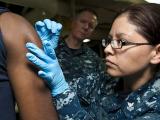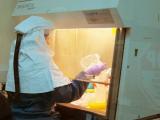Nov 16, 2001 (CIDRAP News) In the current investigation of anthrax cases, the Centers for Disease Control and Prevention (CDC) will try to determine if some parts of the country have a normal background level of anthrax spores that poses no threat to humans and, if so, what that level is, CDC officials said today.
Bradley Perkins, MD, of the CDC's National Center for Infectious Diseases (NCID), noted that the agency is occasionally called on to investigate anthrax outbreaks in livestock. "The places CDC has been involved with recently are in North Dakota and more recently in Texas," he said during a telephone press conference. "We think there may be contamination with spores in these environments that may represent a normal background level. Defining that could be helpful in better guiding cleanup efforts associated with this investigation."
In response to frequent questions in recent weeks, CDC officials have said they are uncertain how large a dose of anthrax spores it takes to cause inhalational anthrax. However, they have indicated that exposure to an environment with very low or trace levels of anthrax is unlikely to be dangerous.
Referring to areas where anthrax has occurred in livestock, Perkins said, "We know the spores are present in those environments, but there's no evidence of human disease as a result of that contamination." He said the CDC plans to conduct studies to determine natural background levels within the next several weeks. "We think that information may help us to extrapolate and better understand what the background levels of B[acillus] anthracis are in the setting of no human health risk."
In other comments, Perkins expressed confidence that preventive antibiotic regimens have saved a number of people from inhalational anthrax in recent weeks. At the same time, he reported no progress in the investigation of the source of the anthrax that killed New York hospital worker Kathy Nguyen, the only anthrax victim whose case has not been linked with contaminated mail.
"We think the interventions . . . have prevented a number of cases of inhalational anthrax, but it's impossible to determine how many people have been spared this life-threatening illness," Perkins said.
His comment came a day after the CDC released recommendations about who should take prophylactic antibiotics for 60 days because of potential anthrax exposure at specific sites. In the Nov 16 issue of Morbidity and Mortality Weekly Reportpublished online Nov 15the agency listed places where a risk of exposure existed on certain days. These include American Media Inc. in Boca Raton, Fla.; postal facilities in New York City, New Jersey, and Washington, DC, and a State Department mailroom in Sterling, Va. For example, anyone who worked in or visited the nonpublic mailroom of the Postal Service facility at 900 Brentwood Rd in Washington, DC, between Oct 12 and 21 should be taking prophylactic antibiotics, the report states.
At a CDC press briefing Nov 15, Julie Gerberding, MD, said the agency is "working hard" to make sure that those who have been instructed to take antibiotics continue taking them for the full 60 days. She said the CDC has provided information about the importance of treatment and about possible side effects and is using "respected and trusted opinion leaders" to counsel workers about compliance. Gerberding is acting deputy director of the NCID.
Responding to a question, Gerberding said the 60-day regimen is based on two pieces of evidence. First, in the 1979 anthrax outbreak at Sverdlovsk in the Soviet Union, people contracted anthrax up to 42 days after the accidental release of the spores. Second, in animal studies, some animals that were treated for 30 days after exposure became ill subsequently.
At the Nov 16 press briefing, officials said the CDC is still working to figure out how Kathy Nguyen contracted anthrax, among other questions. Perkins said the agency is testing environmental samples from a New York subway route that Nguyen is believed to have used, but those tests are not complete. The results, when available, will be released by New York City health officials, he said. He noted that city health officials also are still investigating, and more CDC personnel will be joining the effort in New York this weekend.
Perkins said there is no evidence of any anthrax cases preceding those associated with tainted letters that were mailed on or around Sep 18. Tests related to the case of a New Jersey cardiologist who suspected he might have had cutaneous anthrax early in September have not been completed, he reported. Perkins also indicated that the CDC has not yet determined to what extent anthrax spores can seep out of a sealed envelopethe suspected route of exposure for postal workers in New Jersey and Washington, DC. The agency "will be initiating a number of projects in this regard in the coming months," he said.
At the Nov 16 briefing, Tanja Popovic, a supervisory microbiologist in the NCID, said, "We now have 80 people working full-time, 24 hours a day, seven days a week" on the anthrax investigation. Five CDC laboratories are involved. Before the anthrax attacks, only about 10 scientists in two laboratories were working on anthrax-related projects, she said.
The MMWR report says the CDC has had many anthrax-related inquiries in recent weeks. Between Oct 12 and Nov 13, the agency received 111 inquiries from 66 foreign countries, 26% of them from Central and South America. Between Nov 1 and 12, the CDC received 4,400 calls to a US public hotline for information about anthrax and bioterrorism.
No new cases of anthrax have been identified since Nov 7, according to the MMWR report. The report says that the CDC has confirmed two instances of anthrax contamination outside the United States, both involving samples from the surface of letters or packages sent in State Department pouches to the US Embassy in Peru. The items were processed at a State Department mail-sorting facility [in Sterling, Va]. where a case of inhalational anthrax occurred.
See also:
CDC. Update: investigation of bioterrorism-related anthrax, 2001. MMWR 2001(Nov 16);50(45):1008-10
http://www.cdc.gov/mmwr/preview/mmwrhtml/mm5045a2.htm
Transcripts of CDC telephone press conferences
http://www.cdc.gov/media/transcripts.htm



















